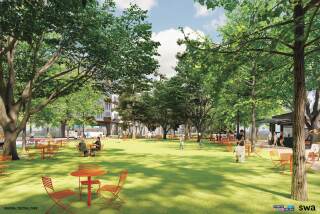D.C. Drivers Steer Clear of Dulles Toll Road
- Share via
WASHINGTON — Gerald Siegel is a commuter who feels downright pampered--and a symbol of the miscalculations that have put a $326-million experiment in private road-building on the brink of financial disaster.
Siegel, who lives in a far Virginia suburb of Washington, regularly uses the new Dulles Greenway toll road, knowing a traffic backup on the Greenway is about as likely as an earthquake.
“I’ve never seen more than a dozen cars going or coming, day or night,” Siegel said. “If I leave work at 9 p.m., there is no one on the road. I feel like it’s my own private road.”
Until it opened for business three months ago, the 14-mile Greenway, which runs from Leesburg to Dulles International Airport, was hailed by many as an example of the private sector’s know-how and initiative. At the ribbon-cutting, U.S. Transportation Secretary Federico Pena said the Greenway was a precedent that offered hope to state and local governments that could not afford major road projects.
But so far the nation’s first privately built highway in more than 150 years has been an embarrassing flop, drawing only a third of the traffic that the road’s owner and operator had predicted.
The shortfall in toll revenue is so great that unless the Greenway company can renegotiate loan terms or find another source of financing, it will have to turn the road over to its creditors, industry observers say, most likely within the next year.
The highway would stay open in such a foreclosure, but the three partners in the company, known as Toll Road Investors Partnership II, could lose as much as $82 million.
To stem its losses, the company laid off a third of its toll collectors in November. To attract more drivers, it postponed a toll increase that was to occur Jan. 1 and said it soon may reduce the $1.75 one-way charge. Cutting the toll could backfire, however, if traffic doesn’t pick up enough to offset the drop in revenue per vehicle.
Traffic on the Greenway is averaging 10,500 vehicles a day and growing by only 1 to 2% a month--far short of the company’s estimate of 34,000 drivers a day by the end of the road’s first year of operation.
Predicting how many drivers will use a road is not easy. But a review of studies the company commissioned and interviews with former company officials suggest that the Greenway investors made fundamental mistakes in calculating the traffic numbers.
In addition, “they certainly need to offer an off-peak discount,” said Peter Samuel, a transportation researcher at the Cato Institute, a public policy research group in Washington. “I’m surprised they haven’t already done that.”
More to Read
Sign up for Essential California
The most important California stories and recommendations in your inbox every morning.
You may occasionally receive promotional content from the Los Angeles Times.













